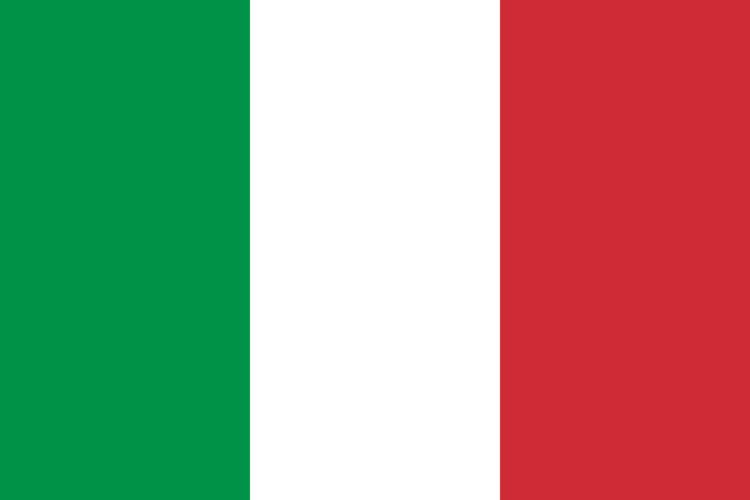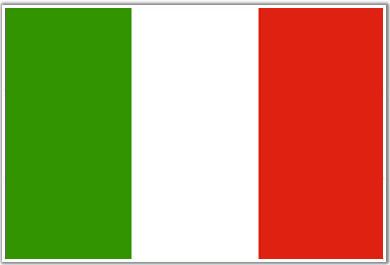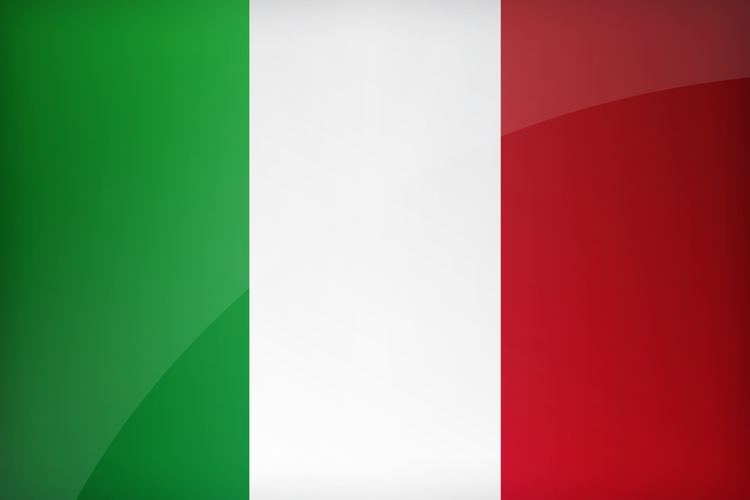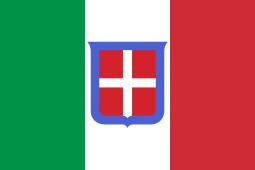Name Tricolore Adopted on 1 January 1948 Country Italy | Use National flag Proportion 2:3 | |
Design A vertical tricolour of green, white and red Design A defaced Italian tricolour Design A defaced Italian tricolour Design A defaced Italian tricolour | ||
Flag of italy
The flag of Italy (bandiera d'Italia, often referred to in Italian as il Tricolore [il trikoˈloːre]) is a tricolour featuring three equally sized vertical pales of green, white and red, with the green at the hoist side. Its current form has been in use since 18 June 1946 and was formally adopted on 1 January 1948.
Contents
- Flag of italy
- 3d rendering of the flag of italy waving in the wind
- Napoleonic era
- Kingdom of Italy
- Fascist regime
- Italian Social Republic
- Italian Republic
- Presidential standard
- Protocol
- Pantone matching system
- Resemblances
- References
The first entity to use the Italian tricolour was the Cisalpine Republic in 1797, which supplanted Milan after Napoleon's victorious army crossed Italy in 1796. The colours chosen by the Cispadane Republic were red and white, which were the colours of the recently conquered flag of Milan; and green, which was the colour of the uniform of the Milanese civic guard. During this time, many small French-proxy republics of Jacobin inspiration supplanted the ancient absolute Italian states and almost all, with variants of colour, used flags characterised by three bands of equal size, clearly inspired by the French model of 1790.

Some have attributed particular values to the colours, and a common interpretation is that the green represents the country's plains and the hills; white, the snow-capped Alps; and red, blood spilt in the Wars of Italian Independence. A more religious interpretation is that the green represents hope, the white represents faith, and the red represents charity; this references the three theological virtues.

3d rendering of the flag of italy waving in the wind
Napoleonic era

The tricolour was reportedly used for the first time on November 13–14. 1794 on a cockade worn by a group of students of the University of Bologna, led by Luigi Zamboni and Giovanni Battista De Rolandis, who attempted to plot a popular riot to topple the Catholic government of Bologna, a city which was part of the Papal States at the time. The law students defined themselves as "patriots" and wore tricolour cockades to signal they were insipred by Jacobin revolutionary ideals, but modified them to distinguish themselves from the French. The chosen colours were white and red since those are the colours of the flag of Bologna, some scholars contend green was added only for the event to give it a more idelogical effect; not all agree that the cockades used by the Bologna plotters actually had three colours, since a myth about that may have been created a year later. On May 18. 1796 a cockade with those colours commemorating the Bologna riots was reportedly presented to Napoleone Bonaparte in Milan, who decided banners with same colours would be carried by the Milan Civic Guard, of the Lombard Legion and the National Guard.

The first official tricolore italiano, or Italian tricolour, was adopted on 7 January 1797, when the XIVth Parliament of the Cispadane Republic, on the proposal of deputy Giuseppe Compagnoni of Lugo, decreed "to make universal the ... standard or flag of three colours, green, white, and red ..." This was probably because the Legione Lombarda had carried banners of red, white (from the flag of Milan), and green (from the uniform of the civic guard), and the same colours were later adopted in the banners of the Legione Italiana, which was formed by soldiers coming from Emilia and Romagna. The flag was a horizontal square with red uppermost and, at the heart of the white fess, an emblem composed of a garland of laurel decorated with a trophy of arms and four arrows, representing the four provinces that formed the Republic

The Cispadane Republic and the Transpadane Republic, which had itself been using a vertical Italian tricolour from 1796, merged into the Cisalpine Republic and adopted the vertical square tricolour without badge in 1798. The flag was maintained until 1802, when it was renamed the Napoleonic Italian Republic, and a new flag was adopted, this time with a red field carrying a green square within a white lozenge.
In 1799, the independent Republic of Lucca came under French influence and adopted as its flag a horizontal tricolour with green uppermost; this lasted until 1801. In 1805 Napoleon installed his sister, Elisa Bonaparte Baciocchi, as Princess of Lucca and Piombino. This affair is commemorated in the opening of Leo Tolstoy's War and Peace.
In the same year, after Napoleon had crowned himself first French Emperor, the Italian Republic was transformed into the first Napoleonic Kingdom of Italy, or Italico, under his direct rule. The flag of the Kingdom of Italy was that of the Republic in rectangular form, charged with the golden Napoleonic eagle. This remained in use until the abdication of Napoleon in 1814.
Kingdom of Italy
Between 1848 and 1861, a sequence of events led to the independence and unification of Italy (except for Venetia, Rome, Trento and Trieste, known as Italia irredenta, which were united with the rest of Italy in 1866, 1870, and 1918 respectively); this period of Italian history is known as the Risorgimento, or resurgence. During this period, the tricolore became the symbol which united all the efforts of the Italian people towards freedom and independence.
The Italian tricolour, defaced with the Savoyan coat of arms, was first adopted as war flag by the Kingdom of Sardinia–Piedmont army on 1848. In his Proclamation to the Lombard-Venetian people, Charles Albert said "... in order to show more clearly with exterior signs the commitment to Italian unification, We want that Our troops ... have the Savoy shield placed on the Italian tricolour flag." As the arms, blazoned gules a cross argent, mixed with the white of the flag, it was fimbriated azure, blue being the dynastic colour, although this does not conform to the heraldic rule of tincture. The rectangular civil and state variants were adopted in 1851.
In the same year, the Grand Duchy of Tuscany became constitutional and dropped the Austrian flag, with Austria–Lorraine great coat of arms, in favour of the defaced Italian tricolour with simplified arms. It is worthy of note, however, that the arms bear the red-white-red flag of Austria, the opponent of Italian unification. In 1859, the Granducato officially ceased to exist, being joined to the Duchies of Modena and Parma to form the United Provinces of Central Italy, which used the undefaced tricolour until it was annexed to the Kingdom of Sardinia the following year.
The flag of the Constitutional Kingdom of the Two Sicilies, a white field charged with the coats of arms of Castile, Leon, Aragon, Two Sicilies, and Granada, was modified by Ferdinand II through the addition of a red and green border. This flag lasted from 3 April 1848 until 19 May 1849. The Provisional Government of Sicily, which lasted from 12 January 1848 to 15 May 1849, adopted the Italian tricolour, defaced with the trinacria, or triskelion.
In the same year, the Kingdom of Lombardy–Venetia revolted against the Austrian Empire in the Five Days of Milan, forming the Provisional Government of Lombardy on 22 March 1848 and Provisional Government of Venice, the so-called "Republic of San Marco", a day later. The flags that they adopted, marked the link to Italian independence and unification efforts; the former, the Italian tricolour undefaced, and the latter, charged with the winged lion of St. Mark, from the flag of the Most Serene Republic, on a white canton. These lasted until 6 and 24 August 1849 respectively.
In 1849, the new Roman Republic adopted an Italian tricolour, sent from Venice, bearing the legend DIO E POPOLO in red capital letters. This lasted for four months, while the Papal States of the Church was in abeyance.
In 1860, the flag of the Kingdom of the Two Sicilies was again modified to the defaced Italian tricolour with the House of Bourbon-Two Sicilies coat of arms. Adopted on 21 June 1860, this lasted until 17 March 1861, when the Two Sicilies was incorporated into the Kingdom of Italy, after its defeat in the Expedition of the Thousand led by Giuseppe Garibaldi.
On 15 April 1861, the flag of the Kingdom of Sardinia was declared the flag of the newly formed Kingdom of Italy. This Italian tricolour, with the armorial bearings of the former Royal House of Savoy was the first national flag and lasted in that form for 85 years until the birth of the Italian Republic in 1946.
Fascist regime
In 1926, the Fascist government attempted to have the Italian national flag redesigned by having the fasces, the symbol used by the Fascist movement, included in the flag. However, this attempt by the Fascist government to change the Italian flag to incorporate the fasces was stopped by strong opposition to the proposal by Italian monarchists. Afterwards, the Fascist government raised the national tricolour flag along with a Fascist black flag in public ceremonies.
Italian Social Republic
The civil and state flag of the short-lived Fascist state in northern Italy, the Italian Social Republic (1943–1945), or "Republic of Salò" as it was commonly known, was identical to the flag of the modern Italian Republic. This was rarely seen, while the war flag, charged with a silver/black eagle clutching horizontally placed fascio littorio (literally, bundles of the lictors), was very common in propaganda. Italian fascism derived its name from the fasces, which symbolised imperium, or power and authority, in ancient Rome. Roman legions had carried the aquila, or eagle, as signa militaria.
On 25 April 1945, known as festa della liberazione, the government of Benito Mussolini fell. The Italian Social Republic had existed for slightly more than one and a half years.
Italian Republic
The Italian tricolour was adopted in its current form on 1 January 1948, with the promulgation of the republican constitution and the end of the reign of the House of Savoy. Article 12 of the Italian Constitution, approved by the Constituent Assembly on the 22 December 1947, states:
The flag of the Republic is the Italian tricolour: green, white, and red, in three vertical bands of equal dimensions.
The universally adopted ratio is 2:3, while the war flag is squared (1:1). Each comune also has a gonfalone bearing its coat of arms.
The Italian naval ensign comprises the national flag defaced with the arms of the Marina Militare; the Marina Mercantile (and private citizens at sea) use the civil ensign, differenced by the absence of the mural crown and the lion holding open the gospel, bearing the inscription PAX TIBI MARCE EVANGELISTA MEVS, instead of a sword. The shield is quartered, symbolic of the four great thalassocracies of Italy, the repubbliche marinare of Venice (represented by the lion passant, top left), Genoa (top right), Amalfi (bottom left), and Pisa (represented by their respective crosses); the rostrata crown was proposed by Admiral Cavagnari in 1939 to acknowledge the Navy's origins in ancient Rome.
In 2003, a state ensign was created specifically for non-military vessels engaged in non-commercial government service; this defaces the Italian tricolour with the national coat of arms. Since 1914, the Italian Air Force have also used a roundel of concentric rings in the colours of the tricolor as aircraft marking; substituted, from 1923 to 1943, by encircled fasces. The Frecce Tricolori, officially known as the 313º Gruppo Addestramento Acrobatico, is its aerobatic demonstration team.
Presidential standard
The President of the Italian Republic has an official standard. The current version is based on the square flag of the Napoleonic Italian Republic, on a field of blue, charged with the coat of arms in gold. Prior to this the field was solid blue. The current coat of arms, more accurately called an emblem as it was not designed to conform to traditional heraldic rules, was adopted in place of the royal arms on 5 May 1948.
After the Republic was proclaimed, the national flag was provisionally adopted as distinguishing flag of the head of state in place of the royal standard. On the initiative of the Ministry of Defence, a project was prepared in 1965 to adopt a distinct flag. Opportunity suggested the most natural solution was the Italian tricolour defaced with the coat of arms; however, under conditions of poor visibility, this could easily be mistaken for the standard of the President of the United States of Mexico, which is also that country's national flag. The standard is kept in the custody of the Commander of the Reggimento Corazzieri of the Arma dei Carabinieri, along with the war flag (assigned to Regiment in 1878)
The Italian Constitution does not make provision for a Vice-President. However, separate insignia for the President of the Senate, in exercise of duties as acting head of state under Article 86, was created in 1986. This has a white square on the blue field, charged with the arms of the Republic in silver. Distinguishing insignia for former Presidents of the Republic was created in 2001; a tricolour in the style of the Presidential standard, it is emblazoned with the Cypher of Honour of the President of the Republic.
In 1927, Mussolini adopted a personal standard consisting of fasces on a Savoy blue field with a yellow border; this was abolished in 1943. Firstly in 2001, and then again from 2008, Silvio Berlusconi adopted a similar standard of the office of Prime Minister, this time the coat of arms proper on a darker blue field with double yellow border.
In 1997, on its bicentenary, 7 January was declared Festa del Tricolore; it is intended as a celebration, though not a public holiday.
Protocol
The law, implementing Article 12 of the Constitution and following of Italy's membership of the European Union, lays down the general provisions governing the use and display of the flag of the Italian Republic and the flag of the European Union (in its territory).
There are no international conventions on flying the flag, but protocol adopted by a large number of countries have such similarities as to suggest lines of commonly accepted practice. In general two areas of exposure are identified: national and international events. In both cases it is generally followed practice that national flags displayed in a group should be of equal size and each hoisted on its own flagstaff, of equal height, or on separate ropes if fixed on yardarm. The flag is flown from sunrise to sunset, except in case of bad weather; exhibition at night is permitted provided it is adequately illuminated. The flag is raised and lowered vividly and with solemnity; it is always treated with dignity and should never be allowed to touch the ground or water. Vertical hoist is transformationally identical to horizontal hoist (i.e. the flag is rotated 90 degrees).
When displayed alongside other flags, the national flag takes the position of honour; it is raised first and lowered last. Other national flags should be arranged in alphabetical order. Where two (or more than three) flags appear together, the national flag should be placed to the right (left of the observer); in a display of three flags in line, the national flag occupies the central position. The European flag is also flown from government buildings on a daily basis. In the presence of a foreign visitor belonging to a member state, this takes precedence over the Italian flag. As a sign of mourning, flags flown externally shall be lowered to half-mast; two black ribbons may be attached to those otherwise displayed. Traditionally, the flag may be decorated with a golden fringe surrounding the perimeter.
Pantone matching system
In 2003, after 206 years of service, the authentic colours of the Italian tricolour were specified by the government, but later amended after hot debate on the chosen shades. As of 2006, the official Pantone textile colours defined by law (and their rendered values in other colour spaces) are:
This approach has been criticised by the Centro Italiano Studi Vessillologici as a "fundamental error." However, it applies only to flags produced on polyester fabric bunting. Other materials should produce the same chromatic results obtained on the sample kept in the State Ceremonial Department of the Presidency of the Council of Ministers, as well as in every Prefecture and Italian diplomatic mission abroad.
Resemblances
Given the superficial similarities between the two flags, the Italian flag and the Mexican flag have been compared over time. However, the Italian tricolour actually uses lighter shades of green and red and, more importantly, the two have different aspect ratios; the Italian flag's aspect ratio is 2:3, while the Mexican flag's aspect ratio of 4:7 results in a more elongated rectangular shape. When Italy became a republic in 1946, the Mexican naval ensign was a plain tricolour; for this reason, on demand of the international naval authorities, Italy could not adopt a sole national flag similar to France as it wished.
Given its possible derivation from the French tricolour, the flag of Italy is similar to many flags of putatively similar origins. The Italian tricolour is particularly similar to the flag of Ireland, which is green, white, and orange (a tone very similar to the red used in the Italian flag), but with different proportions (1:2 against 2:3) and the flag of Côte d'Ivoire, in which the colours, orange, white, and green are reversed, while the proportions are the same. Confusion may also exist between the Italian tricolour (particularly when hoist vertically) and the flag of Hungary, which has the same colours positioned horizontally, although with red uppermost.
The Italian flag is also similar to the Belgian and Romanian flags.
